Unit 6 Do you like bananas?Sestion A 1a-2c教学设计及评析
- 格式:pdf
- 大小:1.38 MB
- 文档页数:3
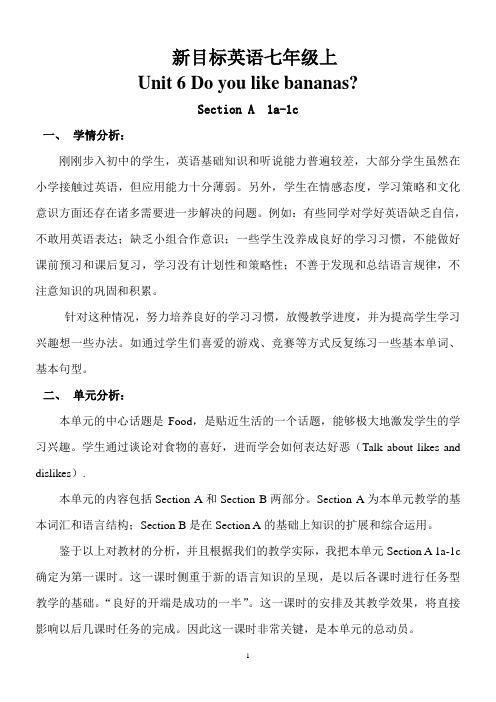
新目标英语七年级上Unit 6 Do you like bananas?Section A 1a-1c一、学情分析:刚刚步入初中的学生,英语基础知识和听说能力普遍较差,大部分学生虽然在小学接触过英语,但应用能力十分薄弱。
另外,学生在情感态度,学习策略和文化意识方面还存在诸多需要进一步解决的问题。
例如:有些同学对学好英语缺乏自信,不敢用英语表达;缺乏小组合作意识;一些学生没养成良好的学习习惯,不能做好课前预习和课后复习,学习没有计划性和策略性;不善于发现和总结语言规律,不注意知识的巩固和积累。
针对这种情况,努力培养良好的学习习惯,放慢教学进度,并为提高学生学习兴趣想一些办法。
如通过学生们喜爱的游戏、竞赛等方式反复练习一些基本单词、基本句型。
二、单元分析:本单元的中心话题是Food,是贴近生活的一个话题,能够极大地激发学生的学习兴趣。
学生通过谈论对食物的喜好,进而学会如何表达好恶(Talk about likes and dislikes).本单元的内容包括Section A和Section B两部分。
Section A为本单元教学的基本词汇和语言结构;Section B是在Section A的基础上知识的扩展和综合运用。
鉴于以上对教材的分析,并且根据我们的教学实际,我把本单元Section A 1a-1c 确定为第一课时。
这一课时侧重于新的语言知识的呈现,是以后各课时进行任务型教学的基础。
“良好的开端是成功的一半”。
这一课时的安排及其教学效果,将直接影响以后几课时任务的完成。
因此这一课时非常关键,是本单元的总动员。
三、教学目标1、知识和能力目标学会并掌握各种食物的英文名称;掌握句型“Do you like……?Does he/she like…? Do they like…?”及其肯定回答和否定回答;学生听说能力的训练。
2、过程与方法目标通过观看英文短片,猜食物,游戏竞赛,角色表演,课堂调查等活动,激发学生的学习兴趣,让学生在快乐中掌握本课时的重点和难点。
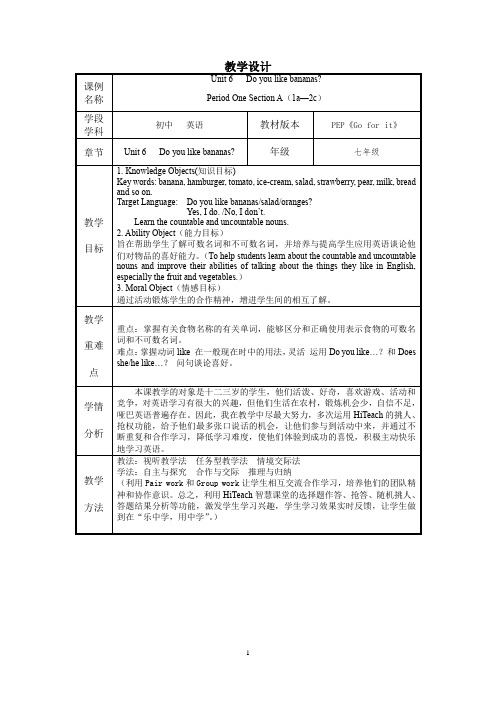
教学过程运用Hiteach Pairwork:两人一组 计时、抢答功能 练习Do you like 句型开始Lead-in:Let’s go to the shop to buysomething for John. Learn some new words.课件运用Hiteach 巩固上一环 抢答功能 节所学单词运用Hiteach 让学生在规定时间 计时功能 内完成单词分类 Listen 1b 学习Do you like 句型.课件正确率大于90%结束运用Hiteach Pairwork:两人一组随机挑人功能 练习Does he/she like 句型运用Hiteach Groupwork:小组内做调查 实物提示功能 写出表达喜恶的短文并展示运用Hiteach Exercise:测试学生 即时反馈功能 掌握情况讲解相关知识运用Hiteach Chain play:熟 抢答功能 练掌握句型Listen 2b 练习所学单词.课件TF总结归纳.课件9. Do a surveyStep3.Exercise:1. Tom pears?A. Do; likeB. Does; likeC. Does; likesD. Is; likes2. you milk?A. Do; likeB. Does; likeC. Does; likesD. Is; likes3. I like hamburgers. But I don’t like______.A. breadsB. breadC. pearD. salads4. Bill likes oranges, but he ______ apples.A. doesn’t likesB. doesn’t likeC. don’t likeD. aren’t5. Do you like strawberries?No,__________.A. I do.B. I does.C. I don’tD. I doesn’tStep4.Homework1.Recite the words.(p31)2.Write a report about your family.Foodtomatoes oranges salad bananas pears milk bread Namemotherfatherbrother…。

集体备课教学设计课题Unit 6 Do you like bananas?Section A(1a—2c)时间October24主备人April Han 年级7 课时 1 课型New教材简析本单元的主要语言功能是围绕“Food”展开教学活动,学习动词like的一般现在时的用法。
在已学习用“Do you have a soccer ball?”来确认物品所属及对各项运动的看法和感受的基础上,进一步以“F ood”为话题谈论个人的喜好问题, 引导学生养成良好的饮食习惯,了解健康食品的概念。
所以本单元是继续学习巩固上一单元开始涉及的一般现在时态,拓展生活中饮食方面的词汇,让学生学会善于表达喜欢和不喜欢的情感。
本节课是本单元的SECTION A部分的第一课时(1a-2c),涉及到不同种类的食物以及学生通过句型的学习学会相互询问对食品的喜恶,其中图片与词语的匹配,听力以及结对活动的设置使难度层层递进,更有梯度。
学生在前一单元已接触了一般现在时的形式,为本节课的学习奠定了基础。
目标预设1、掌握单词:hamburgers, tomatoes, oranges, pears, ice cream, broccoli, salad, French fries, strawberries, like掌握句型:Do you like …? Yes, I do./No, I don’t.Does he like…? Yes, he does. No, he doesn’t.2、了解并掌握可数名词以及不可数名词的用法。
3、通过学习能够表达喜欢和不喜欢的食物,体现英语的实用性。
教学重难点重点:掌握重点词汇和句型难点:1.可数名词与不可数名词的运用。
2.运用本课时重点词汇和句型表达喜欢和不喜欢的这类情感。
课前学生知识准备1.翻译有关食物的单词. (学科长检查)2.试读本课所学单词,并将它们分类(课上教学同步检查)hamburgers, tomatoes, oranges, apples, pears, French fries, strawberries ice cream, broccoli, salad3.阅读课本P95, 可数名词复数形式的变换规则,完成表格(课上教学同步检查)4.翻译句子(学科长检查)教学过程与内容教师活动教法策略学生活动学习策略Before class: Play an English songStep 1. Warming up1.Play a video2.Give the students 1minute to discuss the words about fruit and vegetable that they have learnt.Step 2 PresentationShow pictures and teach new words:apple, orange, strawberry, pear, banana, broccoli, tomato, hamburger, French fries, salad (ask the questions:A: Do you like apples?B: Yes, I do. I like apples.No, I don’t. I don’t like apples. A: Does Jenny like bananas? B:Yes, she does. She likes …No, she doesn’t. She doesn’t…Step3 Practice1.GroupworkAsk and answer in pairs.A: Do you like bananas?B: Yes, I do. I like bananas.( No, I don’t . I don’t like bananas.)C: Does he like bananas?D: Yes, he does. He likes bananas. (No, he doesn’t. He doesn’t like bananas.)提高学习氛围通过播放动画,引出本课内容,提高学生英语学习兴趣,活跃气氛通过图片展示学习新单词,能很快提起学生学习兴趣,让学生直观了解并记忆词汇通过教师与学生的交流,为学生的对话练习做示范指导学生倾听能力通过学生模仿教师与小组其他学生一起对话练习,鼓励学生勇于表达学唱英文歌看动画,找出里面所提到的有关食物的单词小组讨论小学所学过的有关食物的单词并展示拼读单词并记忆回答教师问题,与教师互动小组内进行对话问答通过英文歌曲提高学习兴趣通过小组的交流拓宽知识面,提高记忆单词能力通过不同形式的拼读练习,掌握和巩固新词汇通过与老师的交流,提高学生的学习兴趣,让学生乐于表达,敢于表达通过句型操练使学生更加熟练掌握所学句式教师活动教法策略学生活动学习策略2.Sum up the grammar:①countable noun and uncountable noun②Single form and plural form of the countable nouns.3.Listening①1a, check answers②P31, 1b.③P32,2a, 2b.4.Guessing game:Using the sentences to guess:1.Do they like…?2. Does he like…?3. Do you like…?Step4 Task本周末你邀请了你的朋友们到家里来做客,你打算准备一些食物招待大家。
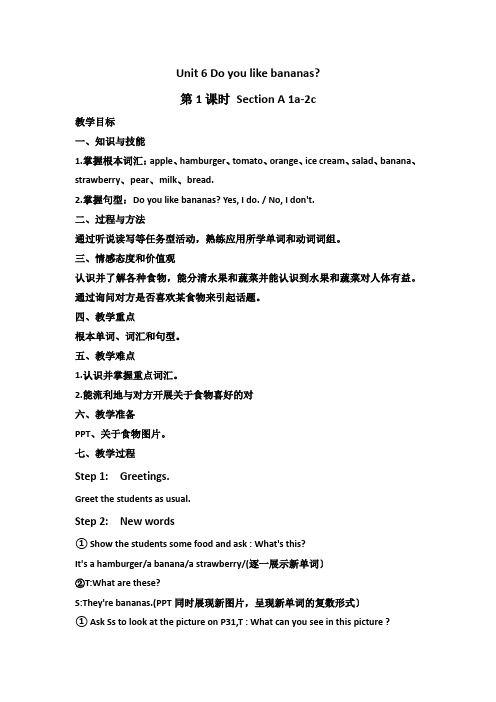
Unit 6 Do you like bananas?第1课时Section A 1a-2c教学目标一、知识与技能1.掌握根本词汇:apple、hamburger、tomato、orange、ice cream、salad、banana、strawberry、pear、milk、bread.2.掌握句型:Do you like bananas? Yes, I do. / No, I don't.二、过程与方法通过听说读写等任务型活动,熟练应用所学单词和动词词组。
三、情感态度和价值观认识并了解各种食物,能分清水果和蔬菜并能认识到水果和蔬菜对人体有益。
通过询问对方是否喜欢某食物来引起话题。
四、教学重点根本单词、词汇和句型。
五、教学难点1.认识并掌握重点词汇。
2.能流利地与对方开展关于食物喜好的对六、教学准备PPT、关于食物图片。
七、教学过程Step 1: Greetings.Greet the students as usual.Step 2: New words①Show the students some food and ask : What's this?It's a hamburger/a banana/a strawberry/(逐一展示新单词〕②T:What are these?S:They're bananas.(PPT同时展现新图片,呈现新单词的复数形式〕①Ask Ss to look at the picture on P31,T : What can you see in this picture ?②Do 1a in pairs work③Check the answers together.Step 5: Present new sentences①T show a picture of food and ask T: among all of the food ,can you guess whatkind of food do l like?(教师解释中文意思〕S : banana / orange / pear / milk .②T:I like bananas/ oranges/pears/strawberries/I don't like milk / hamburgers .T: I like bananas. Do you like bananas?Ss: Yes I do./No I don't.(教师引导学生说出答案〕T: Do you like oranges/salad?Ss:Yes, I do/No, I don't(全班答复,个别检查。
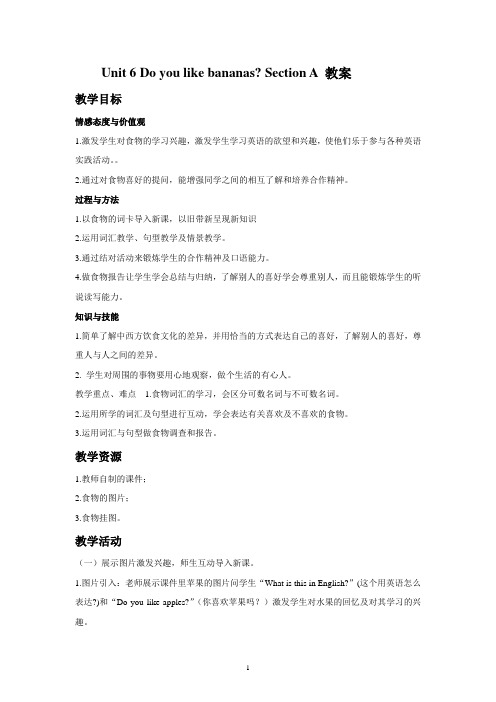
Unit 6 Do you like bananas? Section A 教案教学目标情感态度与价值观1.激发学生对食物的学习兴趣,激发学生学习英语的欲望和兴趣,使他们乐于参与各种英语实践活动。
2.通过对食物喜好的提问,能增强同学之间的相互了解和培养合作精神。
过程与方法1.以食物的词卡导入新课,以旧带新呈现新知识2.运用词汇教学、句型教学及情景教学。
3.通过结对活动来锻炼学生的合作精神及口语能力。
4.做食物报告让学生学会总结与归纳,了解别人的喜好学会尊重别人,而且能锻炼学生的听说读写能力。
知识与技能1.简单了解中西方饮食文化的差异,并用恰当的方式表达自己的喜好,了解别人的喜好,尊重人与人之间的差异。
2. 学生对周围的事物要用心地观察,做个生活的有心人。
教学重点、难点 1.食物词汇的学习,会区分可数名词与不可数名词。
2.运用所学的词汇及句型进行互动,学会表达有关喜欢及不喜欢的食物。
3.运用词汇与句型做食物调查和报告。
教学资源1.教师自制的课件;2.食物的图片;3.食物挂图。
教学活动(一)展示图片激发兴趣,师生互动导入新课。
1.图片引入:老师展示课件里苹果的图片问学生“What is this in English?”(这个用英语怎么表达?)和“Do you like apples?”(你喜欢苹果吗?)激发学生对水果的回忆及对其学习的兴趣。
2.导入课题:展示香蕉的图片问学生同样的问题,导入新课题《Do you like bananas?》(你喜欢香蕉吗?)3.设置疑问,引发思考,激发兴趣:“What kind of fruit do you like?”(你喜欢哪一种水果?)“What food do you like except bananas?”(除了香蕉你还喜欢什么食物?)让我们一起来看看老师今天给你们带来了什么美味的食物吧!(二)新授单词,讲解可数名词及不可数名词。
1.展示可数名词的同一种食物单个数量及多个数量的图片,用句型“What is this?”和“What are these?”来提问,让学生来回答和区分可数名词的单数及复数形式的变化规则。
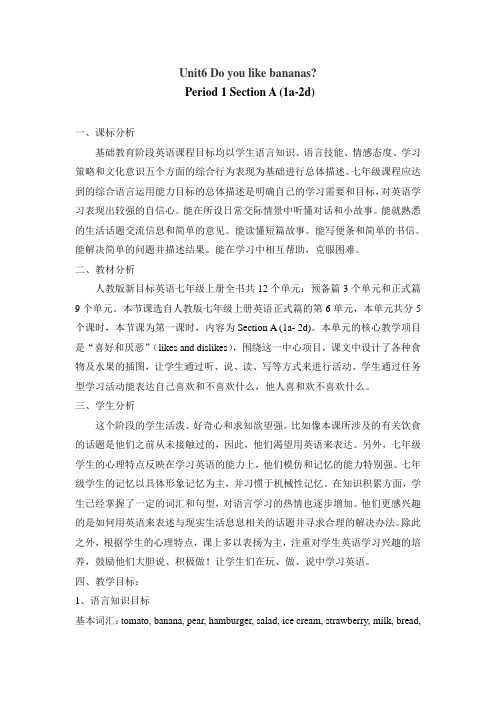
Unit6 Do you like bananas?Period 1 Section A (1a-2d)一、课标分析基础教育阶段英语课程目标均以学生语言知识、语言技能、情感态度、学习策略和文化意识五个方面的综合行为表现为基础进行总体描述。
七年级课程应达到的综合语言运用能力目标的总体描述是明确自己的学习需要和目标,对英语学习表现出较强的自信心。
能在所设日常交际情景中听懂对话和小故事。
能就熟悉的生活话题交流信息和简单的意见。
能读懂短篇故事。
能写便条和简单的书信。
能解决简单的问题并描述结果。
能在学习中相互帮助,克服困难。
二、教材分析人教版新目标英语七年级上册全书共12个单元:预备篇3个单元和正式篇9个单元。
本节课选自人教版七年级上册英语正式篇的第6单元,本单元共分5个课时,本节课为第一课时,内容为Section A (1a- 2d)。
本单元的核心教学项目是“喜好和厌恶”(likes and dislikes),围绕这一中心项目,课文中设计了各种食物及水果的插图,让学生通过听、说、读、写等方式来进行活动。
学生通过任务型学习活动能表达自己喜欢和不喜欢什么,他人喜和欢不喜欢什么。
三、学生分析这个阶段的学生活泼、好奇心和求知欲望强。
比如像本课所涉及的有关饮食的话题是他们之前从未接触过的,因此,他们渴望用英语来表达。
另外,七年级学生的心理特点反映在学习英语的能力上,他们模仿和记忆的能力特别强。
七年级学生的记忆以具体形象记忆为主,并习惯于机械性记忆。
在知识积累方面,学生已经掌握了一定的词汇和句型,对语言学习的热情也逐步增加。
他们更感兴趣的是如何用英语来表述与现实生活息息相关的话题并寻求合理的解决办法。
除此之外,根据学生的心理特点,课上多以表扬为主,注重对学生英语学习兴趣的培养,鼓励他们大胆说、积极做!让学生们在玩、做、说中学习英语。
四、教学目标:1、语言知识目标基本词汇:tomato, banana, pear, hamburger, salad, ice cream, strawberry, milk, bread,vegetable, fruit, food, apple, egg, carrot, rice, chicken基本词组:How about……? What about……? think about基本句型:1. Do you like bananas ? Yes, I do. / No, I don’t.2. Does she /he like bananas ? Yes, she /he does ./No, she/he doesn’t. 2、技能目标: 通过任务型学习活动能表达自己喜欢和不喜欢什么,他人喜欢和不喜欢什么。
Unit 6 Do you like bananasUnit 6 Do you like bananas 教学设计⑥Section 2一、Teaching Goal:In this unit students learn to talk about what people are doing. Teach students how to cooperate and be good at watching something and love our lives.二、Teaching difficulties1. The vocabulary and the sentence structures.2. Learn the grammar: Present progressive tense.3. Oral practice using the target language.三、Teaching MethodsListening and practicing methods, pair work, Task-Based Learning method.四、Teaching AidsA tape recorder, some pictures and cards.五、Teaching Time: 5 periodsPeriod 1 (Section A:1a—2b)Teaching ProceduresStep 1.Revision1. Greetings.2. Revise the words and expressions in Unit 4.Step 2.Presatation: Lead in1. Do “Ask and answer〞 practice with the Ss.2. The teacher asks the students to give more verbs phrases and write them down on the blackboard.(show many pictures to help the Ss.)Teach the new words and expressions.3. Teach the Present Progressive.1〕Introduction: Talk about the title of this unit. Show some pictures to introduce the Present Progressive tense.T: What’s she/he doingSs:She/He is v-ing (Help the Ss to answer the questions and show the sentences)2) Let the Ss to say what the Present Progressive is.(现在进行时表示现在正在进行或发生的动作, 它的表现形式为:Be Verbs + V-ing ….)3). Tell the differenceWrite down the V-ing forms by another lines of go, watch, do, play and eat . Ask the Ss to have a look and find the difference between them. For example: go and going, watch and watching, do and doing, etc. Then ask the Ss to read them again and do more exercises.Step3.Activity 1a:Match1. Help the Ss talk about the pictures. The Ss read these V-ing wordsafter the teacher. Match the words and the activities. Check the answers.2. Help the Ss do “Ask and answer〞 practice in pairs.3. Ask some Ss to do actions and let the class guess what he/she is doing. Step4.Activity 1b & 1c: Listening and pair work.1. Play the recording for the Ss to listen. Play again. Ss listen and write the number of the activity each person is doing. Check the answers.2. Pairwork: Ask the Ss to do “Ask and answer〞 practice about the picture in pairs. Some pairs present their dialogues to the class.Step 5.Activity 2a & 2b: Listening and Practice1.Activity 2a:Talk about the picture in 2b.Ask the Ss to read the questions in 2a. Then listen to the tape and and write the answers. Check the answers.2.Activity 2b:Play the recording again. Help the Ss put these questions and answers in order to make a conversation. Go through the answers with the Ss.Step 6 Pairwork: Activity 2c1.Talk about the pictures in 2c. Ask Ss to read the sample conversation. Let Ss lookat the first group of pictures, and ask them to guess what the people are doing.2. Then imitate the sample conversation, work in pairs. Some pairs present their dialogues to the class.3. A guessing game: Guess the activities ac cording to the Ss’ actions.Step 7 Grammar focusGo through the sentences with the Ss. Deal with some language points.Step 8 Homework: 1.Copy the new words and recite.2.Make up their own dialogues.。
初中英语公开课Unit 6 Do you likebananas? 教学设计简案教学设计Unit 6 Do you like bananas? (Peirod One)Teaching Aims: To learn to saysome food in English, ask and anwer about some’s likes, to tryto make a simplesurvey in English, to know healthy and unhealthy food.Teaching Method: Task-Based Language TeachingTeaching Importantand difficult points: Do you like bananas?Yes, I do. / No, I don’t.Teaching Aids: blackboard, tracebook, pictures, tape recorder and some food.Teaching Steps:Step 1. Lead-inShow students some real food and asktheir likes or dislikes.Step 2. New wordsteachingShow some pictures of the food and teachthem to read the words for several times.Then let students try to speak out thefood as soonas possible.Try to classify all the food: “healthy”or “unhealthy” and write them in the right column.Step 3. New SentencePattern teaching“ Do you like bananas? Yes, I do. / No, I don’t.”Teach the students how to read and writethe new sentence pattern.Then the teacher can ask some stuentsaccording to the pictures. The students should answer corectly according totheir likes and dislikes.Step 4. Guessing gamePick some students to stand in front andpick a kind of food he/she likes. Other students can ask him/her”Do you likeapples/strawberries….?” If not, anwer”No, I don’t.” If do, anwer “Yes, I do.”The student who asks the right food can get a prize.Step 5. Group workLet the students work in pairs to get tofamiliar with the new words and new sentence patterns.Step 6. ListenningListen and finish the blanks on the book,listenagain to understand the listening material.Step 7. HomeworkMake a report about what your calssmateslike or dislike by using the sentence pattern we learn today.。
一、教材内容分析本单元主要围绕“谈论对食物的喜好”这一交际功能展开,并以like为例,进一步学习实义动词在一般现在时中的用法。SectionA部分主要让学生使用动词like询问他人是否喜欢某种食物,学习一般现在时第一人称和第二人称的肯定句、否定句和一般疑问句的构成以及回答。在学习一些食物名称时,让学生初步了解可数名词、不可数名词的概念,并进一步归纳、总结名词复数的构成规律和用法。1a-1c呈现了本单元核心词汇和句型A:Doyoulike...?B:Yes,Ido./No,Idon’t.并让学生尝试运用该句型与同伴就彼此的饮食喜好进行问答。2a-2c部分继续围绕“准备生日派对”这一话题,进行听说教学。听力中呈现出like第一人称的肯定句Ilike...和否定句Idon’tlike...本节课是一节听说课。二、教学目标1.语言知识目标①学习有关食物的词汇:banana,hamburger,toma-to,ice-cream,salad,strawberry,pear,milk,bread.②掌握以下知识目标:Doyoulikebananas?YesI,do./No,Idon’t./Ilikebananas./Idon’tlikebananas.2.语言技能目标①听力技巧指导,听关键词,快速记录;②学会使用动词like询问他人是否喜欢某种食物。3.情感态度通过学习一些中西方典型食品,学生了解中西方饮食文化差异;通过谈论饮食喜好,学生养成良好的饮食习惯。三、教学重、难点教学重点:熟练掌握有关食物的词汇和询问他人喜好的句式。教学难点:正确使用表示食物的可数名词、不可数名词和既可数又不可数名词。可数食物名词的词形变化,归纳可数名词变复数的构成规律和读音。四、教学步骤Step1Lead-inT:Iwanttohaveabirthdayparty.Ihavemanythingsforyou.Now,lookatthepicture,doyouknowthem?Doyoulikebananas?OK,todaylet’slearnthenewlessonUnit6Doyoulikebananas?SectionA1a-2c.(Write“Unit6Doyoulikebananas?SectionA1a-2c”ontheblackboard.)Step2Newwords1.Presentthenewwords.T:What’sthepictureabout?S1:Food.T:Whatarethey?Let’slearnthenewwords.(Showpicturestoteachthenamesofthefoodsuchas“banana,hamburger,tomato,ice-cream,salad,strawberry,pear,milk,bread.”)2.Readthenewwordstogether.3.SaytheEnglishwordsaccordingtotheChinesemean-ing.设计意图:教师以要开生日派对为话题,导入关于对食物喜好这一新课并通过展示图片,让学生直观地学习核心词汇,学生学习的积极性被调动起来,全面参与,共同进步。Step3Grammar1.CountablenounsT:Lookatthesewords(anorange,apear,abanana,ahamburger,astrawberry,atomato),wecanfindouttheyare“anora”,sotheyarecountablenouns.Wecanchangethemintopluralforms.Look!
执教者:牡丹江市第十六中学杨柳评析者:牡丹江市第十六中学王志君
课堂KETANG
15152.Rulesforchangingthesingularformsintopluralforms.T:Nowletmeteachyoutherulesforchangingthesin-gularformsintopluralforms.名词变复数的部分规则如下:
T:Readafterme,payattentiontothepronunciationofthepluralforms.3.CountablenounsandUncountablenouns.T:Fillintheblanksusingthenewwordsaboutthefood.Whichwordsarecountablenouns?Whichareuncount-able?Andwhicharecountableanduncountable?
设计意图:通过学习食物名词,学生能区分这些有关食物的名词是可数名词、不可数名词,还是既可数又不可数名词,并掌握可数名词变复数的变化规律及复数名词的读音。Step4Newdrills1.Presentthenewdrills.T:(Showbananasinfrontoftheclass.)Ilikebananas.Doyoulikebananas?S1:Yes,Ido./No,Idon’t.(Writedownthesentencestructureontheblack-board.)2.Practicethedrills.T:Nowaskandanswer,practicethesentencestruc-ture.S1:Doyoulike...?S2:Yes,Ido./No,Idon’t.设计意图:通过展示香蕉实物,老师介绍喜欢的食物—香蕉,引起学生的兴趣,然后操练新句型,提醒学生like后面的名词是可数名词的复数形式或不可数名词,同时呈现食物图片与句型,逐一练习,以此突破重点句式。Step51aMatchthewordswithlettersT:Openyourbooks.Matchthewordswiththeletters.(Firstlookatthenewwords,sayouttheChinesemeaningsofthesewords.Thenlookatthepicturesofthesefoodinthebook,sayouttheEnglishwords.)设计意图:通过书上图片,学生能看图说单词,并能看单词说出食物名称,巩固新学词汇。Step61bListeningT:Ihavethreefriends,doyouwanttoknowwhattheylikeanddislike?Lookat1b.Listenandnumbertheconver-sations.(Afterlistening,askstudentstoreadtheconversa-tionstogether.Letstudentspayattentiontothetonesofthesesentences.)设计意图:通过听力练习,巩固所学句型。通过跟读听力,提醒学生读三组对话时的音调。Step71cPracticeT:Workinpairs.Practicetheconversationsandmakeyourownconversations.Model:S1:Doyoulikepears?S2:Yes,Ido./No,Idon’t.
课堂KETANG
可数名词(Countablenouns)单数复数anorange———orangesapear———pearsabanana———bananasahamburger———hamburgersastrawberry———strawberriesatomato———tomatoes
1616设计意图:根据表情符号,准确判断出对食物的喜好,操练巩固所学句型。Step8Newdrills1.Presentthenewdrills.T:Ihaveanorangenow,doyoulikeoranges?S:Yes,Ido.Doyoulikeoranges?T:No,Idon’t.Idon’tlikeoranges.Ilikestrawberries.(Writedownthesentencestructure“Ilike.../Idon’tlike...”ontheblackboard.)2.Practice.T:Lookatthescreen,tellmeyourlikesanddislikes.Ilike...Idon’tlike...设计意图:教师以橙子为例与学生进行对话,以此导出新句型Idon’tlike.../Ilike...,并提醒学生like后面接可数名词复数形式或不可数名词,攻克教学难点。Step92a,2blisteningT:Iwanttoinvitemyfriendstomybirthdayparty,wellwhatdotheylike?Listenandcirclethefoodyouhear.(Listenagain.Fillintheblanksandchecktheanswers.)T:Roleplaytheconversations.Boysandgirlsworkintwogroups.设计意图:通过前面的训练,学生应该对所学的生词很敏感,听力练习要求听出关键词。在播放听力后,要求学生能迅速准确写出这些单词,此活动帮助学生巩固所学单词。男女生分角色读对话后,教授let’s句式。Step10GroupworkT:Doyouwanttocometomybirthdayparty?Nowworkingroupswiththenewdrills.Letmeknowwhatyoulikeanddislike,thenI’llbuythemforyou.设计意图:通过小组练习,培养学生的合作意识,鼓励他们可创造性编写对话,进一步巩固本节课所学句型和核心词汇。Step11Summary1.Vocabularyaboutfood.2.Likesanddislikes.T:Atlast,giveyouasaying“Anappleadaykeepsdoctoraway.”Weshouldhaveagoodeatinghabittokeephealthy.Homework.Writedownwhatyoulikeanddislike.板书设计:Unit6Doyoulikebananas?SectionA1a-2c
四、教学评析1.创设情境,自然导入七年级学生活泼好动,且善于接受新事物。因此,为了激发学生对英语课堂内容的兴趣,老师利用一张全是食物的大图片,引发所有学生思考“都有什么好吃的”,然后,把英语单词同实物或情景直接联系起来,增强语言的真实性、形象感,易于调动和保持学生的学习兴趣。2.情境贯穿,词句渗入对于英语学习初级阶段的学生来说,教师采用直观教学的方式,使其一开始就把实物与英语直接联系起来,获得一个直观印象。利用两张图片(一张图是一个苹果,另一张图是多个苹果)来呈现名词单复数变化,让抽象的语法知识点变得既客观具体又贴近学生的生活。在教授新知识的过程中,继续以“开生日派对”为活动情境,并通过表情符号表现出对食物的喜好,从而理解Ilike...和Idon’tlike...的表达句式,通俗易懂,并能记忆深刻。3.一听一说,巩固深入学中有练,练中有学,新授与巩固融为一体。听力语料的主题内容承载着重点语言知识。听力前的活动能使学生感知听力课文中出现的新语言知识,如核心词汇、句型,所以在学习听力活动会产生障碍的词汇及必要的语言知识后,按整节课开生日派对这一情境设计问题,通过听力训练,听出关键词,快速记录下来,巩固所学核心词汇。引导学生积极主动地模仿听力材料———模仿着去读、模仿着去说。通过模仿使学生进入英语学习的最佳状态并获取英语课程的基本知识。本堂课以小组表演、角色朗读形式强化巩固所学句式,pairwork展示表演锻炼了学生的胆量,激励学生敢于在大众面前开口说话,克服心理障碍,提高语言交际能力,培养学生合作探究式学习。见习编辑/李梦迪